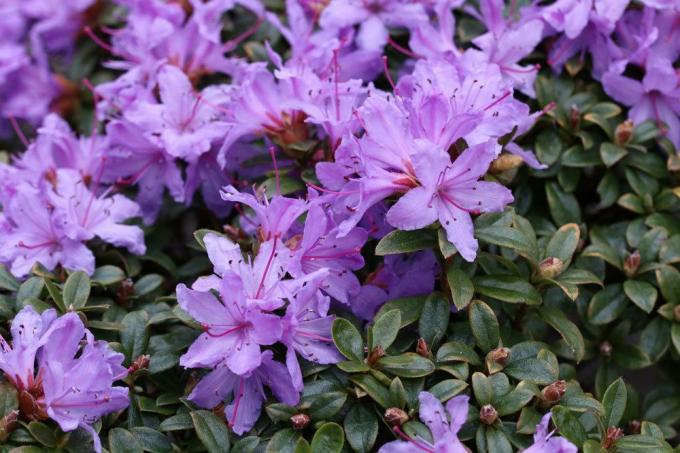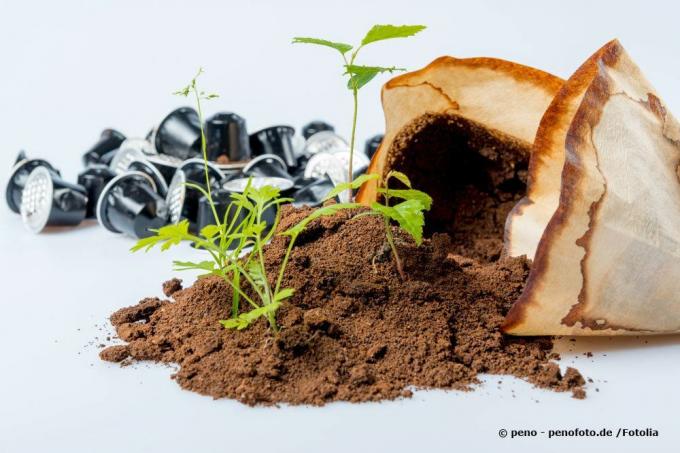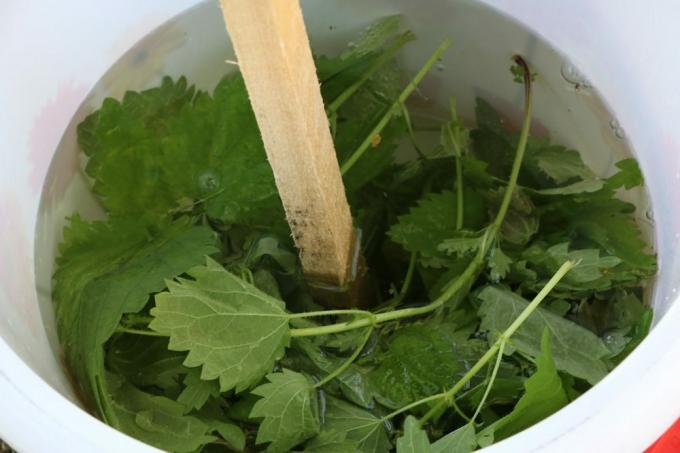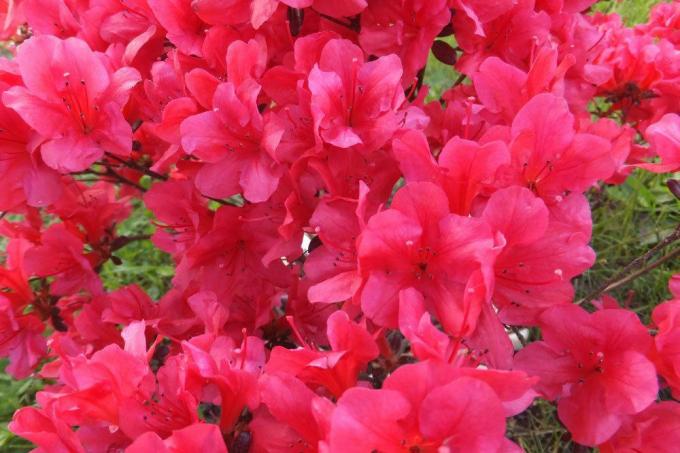
table of contents
- Fertilize rhododendrons
- Coffee grounds
- Compost without the addition of lime
- Deciduous compost
- Bark compost
- Coniferous compost
- Horn shavings or Horn meal
- Horse manure
- Nettle manure
- ash
- Blue grain
- Special fertilizers from the trade
Every year in spring, an otherwise somewhat boring bush turns into a real firework of colors. Everyone has rhododendron his personal shade in which he dips the numerous flower balls. Lovers of these plants can not get enough of the beautiful sight and put together a colorful collection. But does the bush need special building blocks for its flowers so that it never disappoints our expectations? Or can it be compost, horse manure and the like?
Fertilize rhododendrons
What are the requirements of the rhododendron?
Rhododendrons love a balanced supply of nutrients and a low pH of 4 to 5.5. Many organic fertilizers lower the pH value and are therefore ideal for fertilizing this type of plant. However, if the pH is above 7.0, an organic fertilizer will not be enough to bring it down to an acceptable level quickly.
So that you know exactly whether the soil under your specimen is acidic enough, you should measure the pH value. No special knowledge is required for this, appropriate test strips are available in stores. If it turns out to be too high, you can lower it more effectively with an Epsom salt solution.
Coffee grounds
Coffee grounds are a wonderful fertilizer for the rhododendron, which is produced daily and free of charge in almost every household. It contains all the essential nutrients that this flowering bush needs. These are primarily potassium, phosphorus and nitrogen. But it also has a few other advantages that the plant will benefit from:
- lowers the pH value
- attracts earthworms, which loosen the soil
- enriches the soil with humus
- this is ideal for "lime opponents" and "humus lovers" rhododendrons
Since the usual household quantities are not exactly abundant, it may be necessary to use other suitable fertilizers for larger or more rhododendrons. It can be combined with other organic fertilizers without any problems, for example with horn meal. Always work organic fertilizers well into the soil so that the nutrients of soil organisms can be released in a way that is suitable for plants. How To Use This Home Remedy:
- Coffee grounds that are still damp can go moldy
- let dry in a warm place
- best spread out flat on a plate
- then collect in a large container
- Use it to fertilize rhododendrons twice a year

tip: Perhaps there is also the possibility for you to get additional coffee grounds. For example, you could ask about it in a café or ask your neighbors and acquaintances.
Compost without the addition of lime
Domestic compost is welcome to almost every garden plant. It also offers a good combination of nutrients for alpine roses, as the rhododendrons growing in the mountain regions are called. But while most plants can use a well-mixed compost heap, this plant benefits particularly from deciduous, bark and coniferous compost. It is also important not to add the lime that is often used when composting.
Deciduous compost
If you have a lot of oak leaves or leaves of beech and ash available in the fall, you can make deciduous compost from them yourself. This is made for the demanding rhododendron.
- develops low pH
- makes mineral fertilization superfluous
- Apply from March to August
- Spread a 5 cm layer under the bush every two weeks
The rotting of these leaves is very slow compared to normal garden compost, especially since calcareous compost accelerators have to be dispensed with. However, if you stick to it regularly and keep adding fresh leaves, you will always have good compost on hand after two years. Given the long lifespan of an alpine rose, this waiting time is acceptable.
Bark compost
Compost made from pieces of bark also lowers the pH value of the soil. Particularly suitable are:
- Oak bark
- Bark of conifers
This compost should be mixed with clay and lime-free rock flour before spreading. A small amount of sand also increases the permeability. If you don't have the opportunity to make this compost yourself, or if you don't have the patience to wait for the long time it will decompose, you can buy ready-made bark compost in stores. This costs around ten euros per 60 l, but must not be confused with the coarse bark mulch, which is mainly used to protect the roots from drying out. With bark compost, fertilize exactly as described above for leaf compost.
Coniferous compost
Plant parts of conifers are usually not put on a compost heap because they lower the pH too much. For the rhododendron, however, this property is ideal. The coniferous compost, combined with horse manure, horn shavings and garden soil, is an ideal fertilizer for blooming rhododendrons.
- fertilize in the growing season from March to August
- Spread the mixture around the root area
- every 2-3 weeks
- always work in

If the root area of your rhododendrons is covered with a layer of mulch, this must be pushed aside before fertilization. Only then can it be worked into the ground.
Horn shavings or Horn meal
The coarse horn shavings and the fine horn meal are both good for supplying the rhododendrons. It is made from the horns and hooves of animals, the only difference being the different degrees of shredding. The nutrients of the finer horn meal are available to the plants more quickly, while the coarse horn shavings are gradually decomposed for months.
- cheap at around 3 euros per kg
- in every hardware store or Garden center available
- occasionally in supermarkets
- a handful per rhododendron plant is enough
- Apply in March
tip: Rhododendrons are shallow roots. When working in the fertilizer, stay just below the surface to avoid damaging roots.
Horse manure
If you have an opportunity to get horse manure for your yard, take it. Mature horse manure is ideal for fertilizing rhododendrons but also for many other plants in the garden. Ripe manure does not spread the smell that typically penetrates the nose in a cowshed.
- only use mature manure
- fresh manure can burn roots
- approx. 5 l per square meter
- apply in spring
- work in superficially
Nettle manure
Sustainable gardening is the trend and therefore natural fertilizers are moving into the focus of environmentally conscious gardeners. One of them is that Nettle manure. You can easily produce it yourself, free of charge, which makes it a great alternative to expensive specialty fertilizers in terms of price. After all, there is nettle for free on every corner, only a little working time for collecting and preparing, as well as patience during the fermentation period are required. You can fertilize with nettle manure in between, but always diluted 1:10 with water.
- 1 liter of water per 100 grams of fresh nettles
- put in an open bucket
- cover only with a fine net
- let stand in the sun
- stir daily
- fermentation is over when no bubbles appear

tip: The nettle manure smells bad during fermentation. Add some rock flour to neutralize the smell as much as possible.
ash
Ash from organic matter is a suitable fertilizer for rhododendrons. However, only ash from unpolluted wood or wood should be used for fertilization. Coal can be used. When you buy fuel, you can never be sure whether it is contaminated with undesirable substances.
- only fertilize with cooled ash
- Scatter ashes under the rhododendron
Blue grain
This complete fertilizer contains all the nutrients that rhododendrons need, but in high doses. Therefore, care should be taken when fertilizing in order to avoid harmful overdosing. Also because blue grain can be washed out after fertilization and so quickly gets into the groundwater. For the sake of the environment, this should be avoided at all costs.
- Only fertilize with 40 to 120 grams of blue grain per square meter
- exact amount depends on the size of the bush
Special fertilizers from the trade
Those who do not have the time or inclination, perhaps also no opportunity to collect coffee grounds or make a compost heap, can take a look around the large fertilizer department of a garden center. Bark and needle compost are sold there, but also special rhododendron fertilizers. The latter have a combination of nutrients tailored to the needs of the alpine rose. It is up to you which specific fertilizer you buy, but be sure to pay attention to the following aspects:
- Lowering the pH value to pH neutral
- low dosage of salts
- but with plenty of potassium and phosphorus
tip: Yellow leaves indicate a lack of nitrogen. However, a high-priced specialty fertilizer from the trade does not necessarily have to be used; a simple nitrogen-based fertilizer is sufficient to remedy this deficiency.


